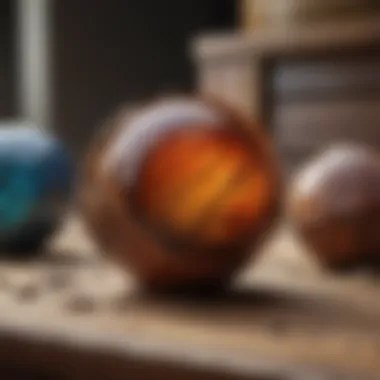Unveiling the Timeless Beauty of Polished Wood: A Comprehensive Guide for Rock and Fossil Collectors


Rock and Fossil Identification
Polished wood specimens hold a unique allure for rock and fossil collectors, offering a blend of natural beauty and intricate patterns that captivate enthusiasts. When identifying rocks and fossils, it is essential to understand the different types that exist in nature. Various characteristics distinguish one specimen from another, such as color, texture, and composition. The discerning collector should arm themselves with essential tools like magnifying glasses, UV lights, and hardness testing kits to aid in accurate identification.
Collecting Tips and Techniques
For rock and fossil collectors eager to add polished wood specimens to their collection, employing best practices is paramount. Locating prime collecting sites often involves research and exploration to uncover areas rich in geological treasures. Upon identifying a potential site, collectors must exercise caution and follow ethical guidelines when extracting specimens to preserve the integrity of the environment and the specimens themselves. Utilizing tools like rock hammers, chisels, and brushes can help collectors safely extract polished wood specimens without causing damage.
Preservation and Display
Preservation techniques play a crucial role in maintaining the quality and longevity of rocks and fossils, including polished wood specimens. Proper storage methods involve protecting specimens from environmental factors like humidity and sunlight, which could lead to deterioration over time. To showcase these exquisite treasures, collectors can explore creative display ideas such as mounting specimens in shadow boxes, building custom display cabinets, or incorporating them into themed collections to enhance their aesthetic appeal.
Geological Insights
Delving into the geological aspects of polished wood specimens unveils a wealth of knowledge about natural formations and processes. Understanding the geological history behind these specimens provides insights into the environmental conditions that existed during their formation. Rocks and fossils hold historical significance, with some specimens dating back millions of years and offering glimpses into ancient ecosystems. Notable discoveries in the field of geology continue to broaden our understanding of the Earth's rich geological heritage.
Introduction
In the realm of rock and fossil collecting, the elegance of polished wood stands out as a captivating subject of exploration. This comprehensive guide embarks on a deep dive into the intricacies and allure of polished wood specimens, offering a valuable resource for enthusiasts seeking to expand their geological treasures collection. From unraveling the history of polished wood to unveiling techniques for preservation and display, this guide is designed to shed light on the many facets of this art form.
Polished wood, often overlooked in traditional rock and fossil collecting circles, holds a unique charm that draws collectors seeking a fusion of nature's raw beauty and human craftsmanship. By understanding the artistry of polishing wood, enthusiasts can appreciate the skill and effort involved in transforming rough wood into a gleaming marvel, suitable for display in both personal and scientific settings.
Exploring the different types of polished wood opens a window to a world of diversity, where each species offers distinct patterns, colors, and textures. Whether it's the rich hues of mahogany or the intricate grains of oak, collectors have a vast array of choices to elevate their collections. By delving into the popular species for polishing, collectors can tailor their acquisitions to match their aesthetic preferences and thematic goals, creating a harmonious display that showcases the beauty of nature's craftsmanship.


In the annals of history, polished wood has held a significant place in various cultures and civilizations. From ancient techniques that date back centuries to the modern resurgence of interest in traditional crafts, the lineage of polished wood resonates with a profound cultural significance. By exploring these historical roots, collectors can gain a deeper appreciation for the heritage and artistry that underpin the practice of polishing wood.
Stay tuned as we navigate through the techniques for collecting polished wood, the best methods for preservation, and innovative ways of displaying these exquisite specimens. This guide is crafted to equip collectors with the knowledge and skills needed to curate and maintain a refined collection of polished wood, enriching their passion for geological treasures and enhancing their aesthetic pursuits.
Understanding Polished Wood
In the realm of rock and fossil collecting, the significance of understanding polished wood cannot be overstated. Polished wood specimens hold a unique allure for collectors, combining the beauty of natural wood with the artistry of human polishing techniques. This section serves as a crucial foundation for enthusiasts, shedding light on the characteristics, properties, and distinctive features that make polished wood a prized addition to any collection. By delving into the nuances of polished wood, collectors gain a deeper appreciation for the craftsmanship involved in enhancing the aesthetic appeal of these organic treasures.
The Artistry of Polishing
When it comes to the artistry of polishing, meticulous attention to detail is paramount. Skilled craftsmen employ a variety of techniques to transform raw wood into gleaming, lustrous masterpieces. From sanding to buffing, each step in the polishing process contributes to the final sheen and finish of the wood. Through a delicate balance of precision and expertise, artisans bring out the natural grain and hues of the wood, showcasing its inherent beauty in a visually stunning manner.
Types of Polished Wood
Diverse in their composition and appearance, different types of polished wood offer collectors a vast array of choices to explore. Hardwoods such as mahogany and oak exude elegance with their rich colors and intricate grain patterns, while exotic woods like teak and rosewood captivate with their unique textures and visual allure. Understanding the characteristics of each wood type is crucial for collectors seeking to expand their knowledge and appreciation of polished wood specimens.
Popular Species for Polishing
Among the vast selection of wood species suitable for polishing, some stand out as perennial favorites among collectors. Species like ebony, maple, and cherry are highly sought after for their versatility, durability, and distinctive aesthetics. Whether showcasing a smooth, glossy finish or a more matte texture, these popular wood species offer collectors a glimpse into the diverse world of polished wood. By exploring the unique characteristics of each species, collectors can identify the perfect addition to their collection that resonates with their personal tastes and preferences.
History of Polished Wood
In the realm of rock and fossil collectors, the history of polished wood holds a significant place, acting as a bridge between geological wonders and artistic craftsmanship. Understanding the origins of polished wood not only enriches our knowledge but also adds a layer of historical depth to the collected specimens. Tracing back to ancient civilizations, the practice of polishing wood has a colorful past, intertwining with cultural traditions and technological advancements. By delving into the history of polished wood, enthusiasts can appreciate the evolution of techniques and the cultural significance attached to these handcrafted marvels.
Ancient Techniques


Ancient techniques of polishing wood unveil the roots of this delicate art form, showcasing the meticulous craftsmanship required to transform raw wood into glossy treasures. Centuries ago, craftsmen employed manual methods, utilizing natural abrasives like sand and pumice to achieve a polished finish. These early techniques not only highlight the skill and patience of artisans but also reflect the resourcefulness of ancient civilizations in enhancing the aesthetic appeal of wood.
Cultural Significance
Beyond mere aesthetics, the cultural significance of polished wood transcends time and geographical boundaries, showcasing a universal appreciation for natural beauty. Different cultures have imbued polished wood with symbolic meanings, using them in rituals, ceremonies, and daily life. From the ornate objects of power in ancient empires to the artistic expressions of indigenous tribes, polished wood has served as a cultural canvas, reflecting the values and beliefs of diverse societies. Exploring this cultural tapestry enriches the collector's understanding of polished wood beyond its visual allure, offering a glimpse into the rich tapestry of human history and creativity.
Collecting and Preserving Polished Wood
In the realm of rock and fossil collecting, the domain of polished wood holds a unique charm that beckons enthusiasts with its unparalleled allure. The pivotal role of Collecting and Preserving Polished Wood in this comprehensive guide cannot be overstated. Both novices and seasoned collectors stand to benefit significantly from understanding the intricacies of acquiring and maintaining these exquisite treasures. The art of collecting polished wood involves a delicate balance between passion and precision, requiring collectors to hone their eye for quality while also preserving the integrity of each specimen. By delving into various collection techniques, enthusiasts can elevate their curation process to new heights, enriching their collections with rare and visually stunning polished wood specimens.
Techniques for Collection
Embarking on a journey to amass a collection of polished wood specimens necessitates a keen eye for detail and a profound appreciation for the intricate beauty each piece exudes. The process of selecting specimens for collection involves a meticulous evaluation of their unique characteristics, such as grain patterns, color variations, and overall visual appeal. Some collectors may prefer to focus on obtaining specimens from specific wood species known for their exceptional beauty when polished. Additionally, techniques for ethically sourcing polished wood, including responsible purchasing practices and ethical considerations, play a crucial role in cultivating a sustainable and conscientious collection. By delving into the nuances of various collection techniques, enthusiasts can refine their selection process and curate a collection that exemplifies their unique tastes and interests.
Preservation Methods
Preserving the timeless splendor of polished wood specimens requires a comprehensive understanding of effective preservation methods that safeguard their beauty for generations to come. Preservation methods encompass a range of practices aimed at protecting specimens from environmental degradation, moisture damage, and physical wear. Techniques such as sealing, proper storage, and regular maintenance routines are essential for ensuring the longevity of polished wood specimens. Collectors must familiarize themselves with these preservation methods to uphold the integrity of their collection and prevent irreversible damage. By implementing meticulous preservation techniques, enthusiasts can safeguard the beauty and structural integrity of their polished wood specimens, allowing them to be enjoyed and admired for years to come.
Displaying Polished Wood
The art of displaying polished wood specimens is a crucial aspect of rock and fossil collecting, allowing enthusiasts to showcase their treasures in all their splendor. Choosing the right display methods and settings can significantly enhance the visual impact of polished wood specimens, highlighting their unique characteristics and aesthetic appeal. Factors such as lighting, arrangement, and protective casing play a pivotal role in creating an engaging display that captivates viewers and showcases the beauty of each specimen. Enthusiasts can experiment with different display techniques to create visually enchanting arrangements that showcase the diversity and elegance of their polished wood collection. By giving careful thought to the presentation of their specimens, collectors can elevate the viewing experience and create a captivating display that resonates with admirers of geological treasures.
Polished Wood in Art and Decor


In the realm of rock and fossil collectors, the significance of polished wood in art and decor is a multifaceted subject that marries nature's elegance with human creativity. Polished wood, with its rich textures and intricate patterns, serves as a bridge between the organic world and artistic expression. When integrated into interior design, polished wood brings warmth, sophistication, and a touch of nature's beauty to living spaces.
Exploring the integration of polished wood in art and decor unveils a realm of possibilities for enthusiasts seeking to infuse their spaces with the timelessness of natural elements. From furniture to accent pieces, polished wood offers versatility that can complement a spectrum of design styles, from rustic to modern chic.
Moreover, the tactile quality of polished wood adds depth and dimension to interior spaces, creating a sensory experience that appeals to both visual and tactile senses. Utilizing polished wood in art and decor allows individuals to appreciate the intricate details of different wood species, showcasing their unique grains, colors, and textures.
Interior Design Trends
As the design world continually evolves, interior design trends play a pivotal role in shaping aesthetic preferences and redefining spatial experiences. In the context of polished wood, current interior design trends emphasize a blend of traditional craftsmanship with modern minimalism. The art of incorporating polished wood in interior design lies in balancing classic elegance with contemporary sensibilities.
The current trend leans towards eco-friendly and sustainable design practices, where the use of polished wood aligns perfectly with the growing preference for natural materials in interior spaces. Sustainable interior design places a premium on utilizing ethically sourced materials, making polished wood a sought-after element in eco-conscious decor.
In addition, interior design trends showcase a preference for organic textures and earthy tones, creating harmonious environments rooted in nature's aesthetics. The warmth and authenticity of polished wood contribute to this trend by infusing spaces with a sense of tranquility and connection to the natural world.
Artistic Applications
The realm of artistic applications for polished wood extends beyond functional decor to expressive art forms that push the boundaries of creativity. Artists and artisans alike harness the beauty of polished wood to create sculptures, installations, and mixed-media artworks that celebrate the material's innate characteristics.
Artistic applications of polished wood often focus on the juxtaposition of smooth, gleaming surfaces with raw, unpolished elements, creating a visual dynamic that captures attention and sparks contemplation. Through innovative techniques such as inlay work, carving, and resin infusion, artists can transform polished wood into mesmerizing art pieces that tell stories and evoke emotions.
Furthermore, the durability and longevity of polished wood make it an ideal medium for artistic expressions meant to withstand the test of time. Whether used in large-scale installations or intricate veneer detailing, polished wood continues to inspire artists to push boundaries and explore the artistry inherent in nature's creations.
Conclusion
In the world of rock and fossil collecting, the significance of understanding polished wood cannot be overstated. This comprehensive guide sheds light on the intricate artistry of polishing wood, the various types of polished wood available, and the most popular species for collectors. One of the key benefits of this guide is that it enriches enthusiasts with historical insights into the ancient techniques of wood polishing and its cultural significance throughout the ages.
Not only does this guide provide techniques for collecting polished wood specimens, but it also delves into the crucial preservation methods necessary to protect these geological treasures. By following the preservation advice detailed here, collectors can ensure their polished wood pieces remain in pristine condition for generations to come. Additionally, the section on displaying polished wood offers creative ideas on showcasing these specimens in ways that highlight their elegance and beauty.
Moving beyond the practical aspects, the section on polished wood in art and decor explores how these specimens can be integrated into interior design trends and utilized for artistic purposes. From enhancing the aesthetic appeal of living spaces to inspiring creative projects, polished wood stands out as a versatile and timeless material with significant artistic potential.
In essence, this guide serves as an indispensable resource for rock and fossil collectors seeking to deepen their knowledge of polished wood specimens. By engaging with the information presented here, enthusiasts can elevate their collecting experience, appreciate the beauty of these geological wonders, and contribute to the preservation and celebration of polished wood's elegance.







